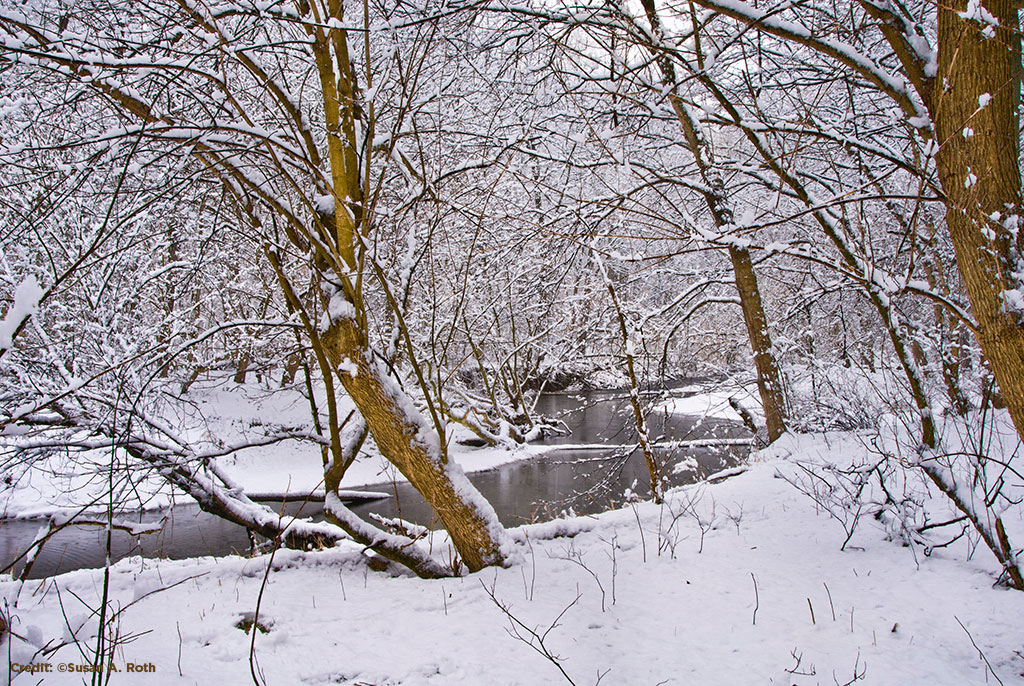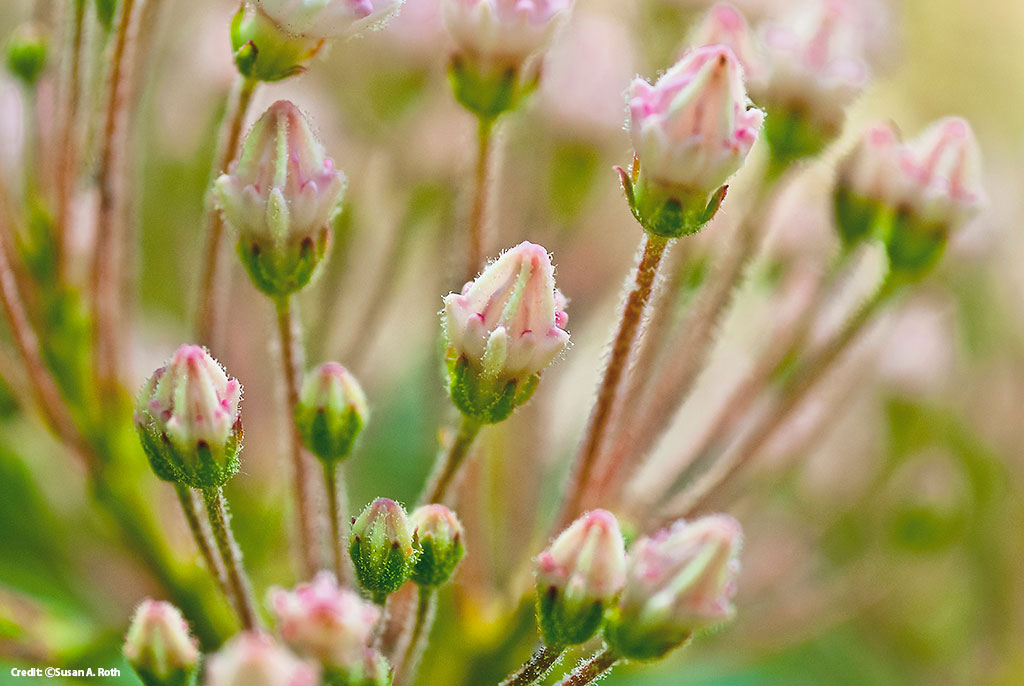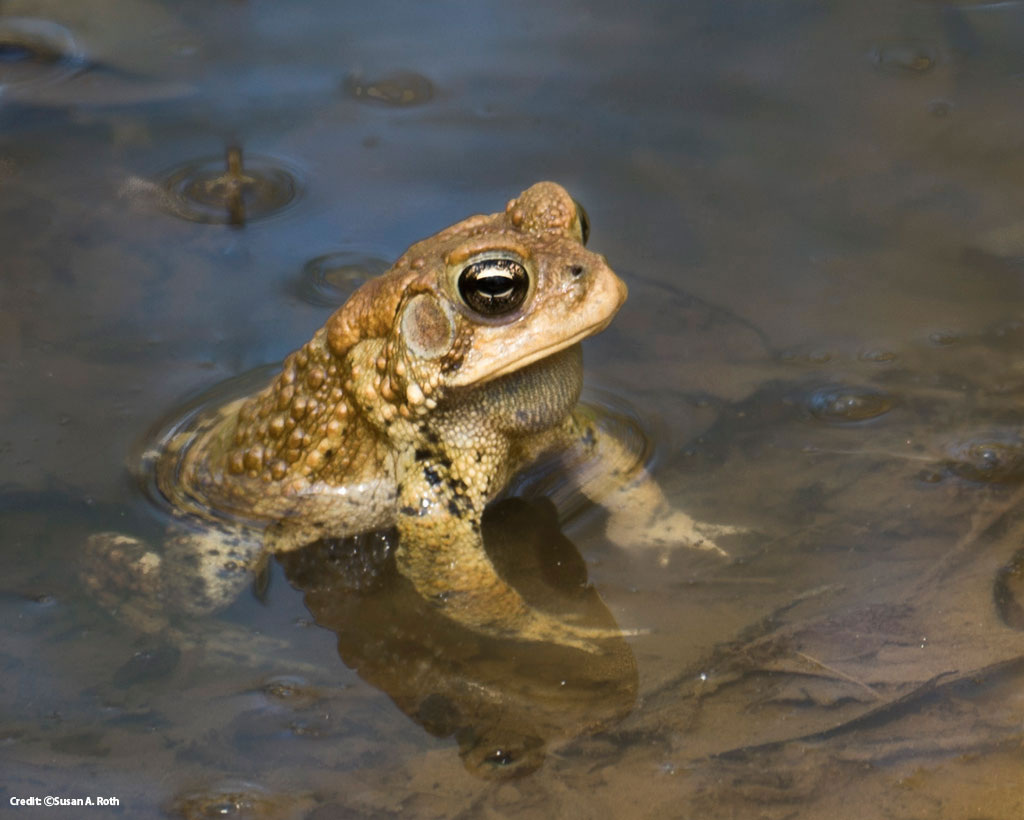Poetic imagery and striking photography take you through one of the most eloquent seasonal transitions in nature.
By Melanie Coukas-Bradley with photographs by Susan Austin Roth

In a national park as old as Yosemite and twice the size of New York City’s Central Park, walkers, runners and cyclists witness an annual transformation as the stark topography of Rock Creek Park’s winter landscape surrenders to the verdancy of early spring. When the days warm in the wild, wooded heart of Washington, D.C., the boxelders overhanging Rock Creek put forth pendent clusters of greenish gold flowers and tender green leaves. Tiny spicebush blossoms form a yellow haze throughout the stream valley as a melodic chorus of spring peepers pipes up from every vernal pool. Wood ducks paddle past budding trout lilies, and phoebes call out as they explore their nesting sites under the West Beach Drive bridge. Work may be gridlocked across town on Capitol Hill, but there’s no stopping the unfurling of the skunk cabbage leaves or the return of the alewives to Rock Creek.
But, lest we prematurely jumpstart the spring season in Rock Creek Park before properly honoring its predecessor, for three months before the first peep from the peepers, the beauty of winter reigns in the nation’s oldest urban national park, which, at 1,754 acres, is also one of the largest. The distinctive bark and architecture of trees that have escaped the axe since 1890 are on mesmerizing display in the leafless crowns of the creamy sycamores, red-barked river birches, dark black walnuts, sinewy ironwoods and tall tuliptrees of Rock Creek’s floodplain forest. When snow falls it creates celestial ice cream cones in the clusters of samaras high up in the tuliptree crowns, and it turns the open beaks of the jimsonweed capsules along the creek’s pebbled beaches into white rosebuds. In the park’s rocky upland woods, the limbs of many species of oak and hickory display their impressive profiles free of leaves along with their distinctive twigs and buds. They are offset by an evergreen understory of mountain laurel and Christmas fern. The smooth pewter of American beech tree trunks is contrasted by the bleached wheat of their marcescent winter leaves all along the Rock Creek Parkway, where they are admired by D.C. commuters, who are collectively grateful for a glimpse of wild winter beauty on the way to their K Street offices.
The unpredictability of Washington, D.C. winter weather brings constant anticipatory excitement and occasional dread to the human inhabitants of the nation’s capital. Freezes and thaws in Rock Creek create scalloped shelves of gold-veined ice that collapse to flood waters on a 50-degree day. The thermometer plunges to the single digits and creek ice forms, snow comes as the slightest flurry or as a coastal blizzard dropping 30 inches of wet powder. Ice skaters practice figure eights on the vernal pools, and cross country skiers traverse the vast network of hiking trails enraptured by the snow-laced stream valley forest.
For Stephanie Mason, who turned her back on a Capitol Hill career many years ago and now serves as Senior Naturalist for the Audubon Naturalist Society (ANS), the stillness of winter among the
leafless trees is punctuated by high drama in the Rock Creek Park winter bird flock.
“Mixed winter flocks of our resident Carolina chickadees and tufted titmice, joined by overwintering kinglets and more, always amuse me with their noisy defiance of an otherwise quiet winter
woods,” Mason says with a smile. “Their many eyes find more food in fewer and more dispersed places. Foraging in the season’s open, mostly leafless woodlands, their flocking behavior also helps the small birds stay alert to avoid predators. Imagine being a hungry sharp-shinned with its eye on one member of the group, only to have the entire flock scatter with explosive speed — and in all directions — as the hawk zooms in for the catch.”
WEED WARRIORS
Rock Creek is 33 miles long. The National Park Service, which celebrates its centennial this year with its theme “Find Your Park,” administers the creek and adjacent parkland within District lines. Montgomery County, Md. parkland dating to the 1930s shelters the creek’s 22-mile journey upstream from D.C., from springs on and around a golf course in Laytonsville, to the humble but legendary landmark at the D.C. border known as Boundary Bridge — one of several footbridges traversing the creek within the national park that dates to Franklin Delano Roosevelt’s New Deal. Together, D.C. and Maryland are fighting to enhance and restore the integrity of the stream valley and its waters under the Clean Water Act.
They have their work cut out for them.

By the time Rock Creek flows past the National Zoo and into the Potomac River near the Georgetown waterfront, it has drained a vast watershed covering thousands of urban and suburban acres.
Stormwater runoff races across all those impervious surfaces and overwhelms Rock Creek and its many tributaries, carrying a heavy and polluting sediment load, eroding streambanks and toppling trees. Programs administered by the environmental protection agencies of both Montgomery County and the District offer instruction and financial incentives to homeowners to help
manage runoff in their yards. Several active nonprofit organizations serving as partners to the National Park Service monitor progress, educate citizens and oversee cleanup events, tree plantings and invasive plant removals, while the Potomac Appalachian Trail Club helps to maintain trails in the face of heavy use and many blowdowns.
Members of these organizations spring into action with annual cleanups and other events with the coming of spring. While laboring on behalf of the health and well-being of the Rock Creek stream valley, there is also time to do some “forest bathing,” as the Japanese call it — kicking back, breathing deeply and contemplating the health-giving beauty of the forest. ANS, whose headquarters in the historic Woodend mansion are located next to Rock Creek in Chevy Chase, Md., has a dual conservation and education mission.
“The Audubon Naturalist Society and Rock Creek Park are old friends,” says ANS Executive Director Lisa Alexander. “Our organization was founded just seven years after Congress set aside Rock Creek Park in 1890. ANS members, including Theodore Roosevelt and Rachel Carson, have been frequent visitors to Rock Creek Park and champions of it.” Alexander adds, “We are lucky to enjoy the beauty of Rock Creek every day. With our headquarters at Woodend Nature Sanctuary nestled inside the Rock Creek Stream Valley, we welcome the hikers and bikers along the Rock Creek Trail who come to discover Woodend. Our environmental educators relish the opportunity to use Rock Creek as a living classroom for the school groups and summer campers they teach.”
The many weed warrior programs focused on Rock Creek Park have made notable progress and, although it’s a steep uphill battle, populations of native plants have gained some breathing space. Carole Bergmann, the Montgomery County Parks Field Botanist and Forest Ecologist who coined the term “Weed Warrior,” has trained thousands of volunteers who are active in her county. The Rock Creek Conservancy has made considerable progress with their mission to eradicate English ivy in the park, and volunteers working with Casey Trees have also removed invasives. The National Park Service has had some success battling a pernicious invader called lesser celandine, or fig buttercup, in the floodplain forest. Consequently, in recent years the display of ephemeral wildflowers near Boundary Bridge has rebounded.
BUDBREAK
With the coming of spring, a creek-side carpet of yellow trout lily and pink and white spring beauty is soon enhanced by Virginia bluebells, Jack-in-thepulpit and later Mayapples and wild blue phlox. In the upland woods, bloodroot flowers are followed by rue anemone, wild geranium and Indian cucumber root. In late April and early May, the wild pinxterbloom azalea puts forth its oversized two-toned pink flowers and, on its heels, fellow heath family member, mountain laurel, dazzles park visitors with its flower buds, which look like “mini-meringues,” and its snowball-shaped flower clusters.

Budbreak among the trees is one of the great spring dramas in Rock Creek Park. One of the earliest buds to break is the duck-bill shaped bud of the tuliptree. Each bud puts forth tiny leaves shaped like a child’s drawing of a tulip flower. These new leaves are an electric spring green, and they seem to reach for the sky like baby’s hands. The silk-lined emerging leaves of the American beech unfurl in the opposite direction, earthward, spiraling out of their pointed mahogany buds like dancers’ skirts. The leaves of both species will eventually lie horizontal, after their very different trajectories into the world.
One of the most improbable budbreak acts belongs to the mockernut hickory. Giant pinnately compound leaves and fistfuls of flowers simply explode from pale, egg-shaped buds. The oaks charm
all comers with their miniature but very grown-up-looking leaves: chestnut, white, swamp white, red, black and scarlet oaks all bear tiny versions of their adult leaves at first, leaves awash in very autumnal-looking colors prior to the advent of chlorophyll.
Many of Rock Creek Park’s trees, such as ashes, oaks, hickories, walnuts and butternuts, bear relatively non-showy wind-pollinated flowers. Standouts among the trees that put their efforts into showy insect-pollinated flowers include the early-blooming shadbush or serviceberry, the flowering dogwood, redbud, tuliptree and the umbrella magnolia.
THE SOUNDS OF SPRING
Spring is the most musical season in Rock Creek Park. Three major amphibious choruses regale park visitors. First to tune up are the wood frogs, who create a duck-like quacking racket during the first warm days of late February or early March. Their rather atonal sound is soon punctuated by the sweet music of the spring peepers, tiny chorus frogs whose collective calling has been compared to the sounds of sleigh bells. Simultaneously, the American toads sing out from every vernal pool and the creek itself, their calls a high and surprisingly musical sounding trill. Rock Creek Park’s ever watchful Natural Resources Specialist Bill Yeaman, who has been looking out for the park’s wildlife for more than 40 years as an employee of the National Park Service, anticipates the park’s amphibian calls each year.

“As spring arrives in Rock Creek Park, the mating chorus of wood frogs, spring peepers, and American toads can be heard calling from the temporary pools along the park’s northern floodplain (near Boundary Bridge),” Yeaman says. “Spring also features the wondrous migration of blueback herring and alewives which make their annual journey from the Atlantic Ocean to Rock Creek to spawn before returning to the sea. A fish ladder was installed near historic Peirce Mill (a 19th century gristmill) in 2006 to enable these migratory fish to reach historic spawning habitat along Rock Creek.”
As the season progresses, waves of spring migrating birds pour into the canopy, adding their songs to the songs and calls of the resident chickadees, cardinals, woodpeckers, white-breasted nuthatches and tufted titmice. Many species of warbler, scarlet tanager, eastern towhee, eastern wood-pewee and the wood thrush — Washington, D.C.’s official bird with the flute-like song — are among the most tuneful members of the avian spring chorus. Some pass through on their way north, but many stay to nest in the dense canopy. Thanks to Steve Dryden’s Rock Creek Songbirds project, returning birds are greeted by a young welcoming committee, which includes many children whose families of origin still reside in the winter homes of Rock Creek Park’s returning birds.
“One of the most fulfilling parts of the Rock Creek Songbirds project for me is connecting with schools in the Mt. Pleasant and Columbia Heights areas of Washington, which abut Rock Creek Park,” Dryden says. “The younger students in these schools are often the sons and daughters of immigrants from Latin America, which is the winter home for so many migrant songbirds. It’s fun — and educational — to tell the kids about the birds that their grandparents saw during winter coming back to Rock Creek Park each spring. At one school, we made a 10-foot banner which proclaimed ‘Welcome Back Songbirds’ in Spanish as well as English. We hung that in the foyer. Later, the class walked to the park and helped plant oaks to improve the habitat for the birds and other wildlife.”
With a little luck, those oaks will grow strong and tall, sheltering and nurturing future generations of returning migrants for decades and centuries to come.
Melanie Choukas-Bradley and Susan Austin Roth are the author and photographer of A Year in Rock Creek Park—the Wild, Wooded Heart of Washington, DC. (GFT Publishing, 2014; paperback edition distributed by the University of Virginia Press). They lead nature walks in Rock Creek Park for many Washington, DC,-area organizations and lecture widely on the natural history of the park.